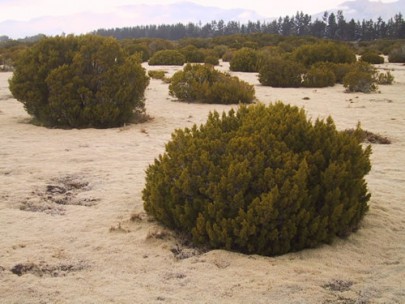Strongly leached terraces and plains ('Wilderness' vegetation)
In this section
-
Inland & alpine
- Basic cliffs, scarps and tors
- Boulderfields of acidic rocks (non-volcanic)
- Boulderfields of calcareous rocks
- Boulderfields of quartzose rocks
- Braided riverbeds
- Calcareous cliffs, scarps and tors
- Calcareous screes
- Cliffs, scarps and tors of acidic rocks
- Cliffs, scarps and tors of quartzose rocks
- Cloud forests
- Frost hollows
- Granitic gravel fields
- Granitic sand plains
- Inland outwash gravels
- Inland saline (salt pans)
- Inland sand dunes
- Limestone erosion pavements
- Moraines
- Old tephra (>500 years) plains (= frost flats)
- Recent lava flows
- Sandstone erosion pavements
- Screes of acidic rocks
- Strongly leached terraces and plains
- Ultrabasic boulderfields
- Ultrabasic cliffs, scarps and tors
- Ultrabasic hills
- Ultrabasic screes
- Volcanic boulderfields
- Volcanic debris flows or lahars
- Volcanic dunes
- Young tephra plains and hillslopes

Strongly leached terraces and plains with bog pine (Halocarpus bidwillii) heathland at The Wilderness Scientific Reserve, Southland (Sarah Richardson)
These ecosystems comprise terraces, outwash plains or dry shingle fans of glacial or fluvial-glacial origin. They are colloquially referred to as ‘Wilderness’ and sometimes erroneously referred to as ‘frost flats’. Strongly leached terraces and plains have unusually low soil fertility for their elevation, and so have been described as examples of early post-glacial succession arrested because of low fertility (Molloy 1975). They are frequenty free-draining and experience cold winters (high incidence of frost) and hot summers (seasonal drought). Bog pine (Halocarpus bidwillii) is diagnostic, forming scattered clumps surrounded by a matrix of mat-forming vegetation or moss/lichenfields.
Synonyms
‘Wilderness’
Notable flora and fauna
Threatened or rare plants include nationally endangered Armstrong whipcord (Veronica armstrongii), declining coral broom (Carmichaelia crassicaulis), relict Coprosma intertexta, and a naturally uncommon fireweed (Senecio dunedinensis).
The rare moth Ericodesma cuneata (Tortricidae) has been found quite commonly at The Wilderness, Southland; larvae are on Corokia.
Threat status
Critically endangered (Holdaway et al. 2012)
Threats
Most examples of this ecosystem have probably been lost to agriculture (high country grazing or arable farming at lower altitudes). Grazing and conversion to pasture are still threats. Weeds include wilding conifers, shrub species, e.g. gorse (Ulex europaeus), Scotch broom (Cytisus scoparius), blackberry (Rubus fruticosus), sweet briar (Rosa rubiginosa), and heather (Calluna vulgaris), broadleaved herbs such as hawkweeds (Hieracium sp.), and introduced grasses. Rabbits and hares are serious threats to woody regeneration. Nutrient enrichment from adjacent irrigation and agricultural intensification may emerge as a threat.
Where do they occur?
All known sites are restricted to the southern and eastern South Island, in the Mavora, Mackenzie, Molesworth, and Puketeraki Ecological Regions.
Further reading
McGlone MS, Moar NT 1998. Dryland Holocene vegetation history, Central Otago and the Mackenzie Basin, South Island, New Zealand. New Zealand Journal of Botany 36: 91-111.
Molloy BPJ 1975. Joint report: proposed scientific reserve: Bendhu. DSIR Vegetation Report 81.
Molloy BPJ 1990. Enrichment of rare plants, Enys and Castle Hill reserves. DSIR Vegetation Report 703.
Peat N, Patrick B 1996. Wild Fiordland: Discovering the Natural History of a World Heritage Area. Dunedin, University of Otago Press. 49 p.
Wardle P 1991. Vegetation of New Zealand. Cambridge University Press. Pp 194.
Links
Broom Control in the Wilderness (Landcare Research)
White E G. 2002. New Zealand Tussock Grassland Moths. Manaaki Whenua Press 366p.


